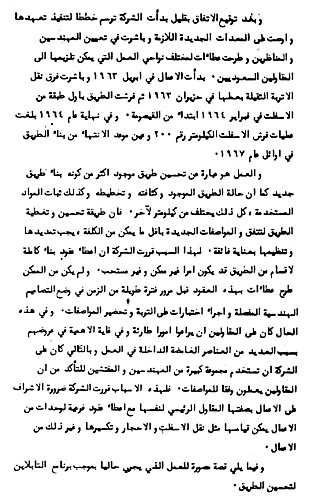|
Soon after the agreement was signed the Company
began making plans to carry out its undertaking, placed orders for new
equipment required, began to, recruit engineering and supervisory
personnel, and prepared bid tenders for various aspects of the work
which could be let to Saudi Arab contractors. Engineering work began
in April 1963, the heavy earth moving crew started in June 1963, and
the first asphalt was applied to the road in February 1964, beginning
at Qaisumah. By the end of 1964 asphalt application reached kilometer
ZOO, and the entire road is scheduled for completion in early
1967.
The work involves the improvement of an existing
road rather than the construction of a new road. and the condition of
the existing road, its thickness, its alignment, and the stability of
the road material varies from kilometer to kilometer. Therefore. the
process of improving and surfacing the road to meet the new
specifications at minimum cost must be very carefully planned and
controlled. For this reason the Company concluded that it would not be
feasible or desirable to attempt to let complete construction
contracts for sections of the road. Such contracts could not have been
offered for bid until a great deal of time had been spent in detailed
engineering design, soils testing, and preparation of specifications.
The contractors would have had to provide for substantial
contingencies in their bids because of the many uncertainties
involved, and the Company would have had to employ a large force of
engineers and inspectors to assure that the contractors were meeting
specifications. For these reasons the Company concluded that it must
control the work by acting as its own prime contractor, with
sub-contracts let to Saudi Arab contractors for units of the work
which could be measured, such as rock crushing, asphalt and rock haul,
etc.
There follows a pictorial story of the work now
being carried out under the Tapline Road Improvement Program.
|

|

